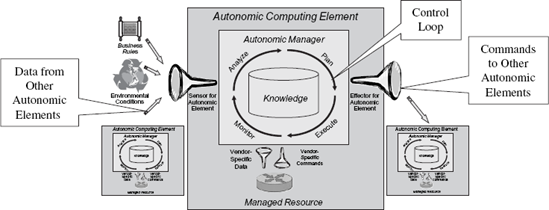2.2. Foundations of Autonomic Computing
This section will describe the IBM autonomic computing architecture in order to illustrate the fundamental points of autonomic computing.
The fundamental management element of an autonomic computing architecture is a control loop, as defined in [] [] and []. This control loop starts with gathering sensor information, which is then analyzed to determine if any correction to the managed resource(s) being monitored is needed. If so, then those corrections are planned, and appropriate actions are executed using effectors that translate commands back to a form that the managed resource(s) can understand. This is conceptually illustrated in Figure 2.1.
Figure 2.1. IBM's autonomic control loop

Autonomic computing uses a control loop to monitor the state of the resource being managed, and take corrective action if the current state of the resource is not equal to its desired state. This usually results in the reconfiguration of that managed resource, though it can also result in the reconfiguration of other managed resources that are affecting the state of the managed resource that is being monitored. More specifically, the elements of the autonomic control loop are responsible for monitoring the managed resource and other relevant data about the environment in which it is operating, analyze those data and take action if the state of the managed ...
Get Cognitive Networks: Towards Self-Aware Networks now with the O’Reilly learning platform.
O’Reilly members experience books, live events, courses curated by job role, and more from O’Reilly and nearly 200 top publishers.

